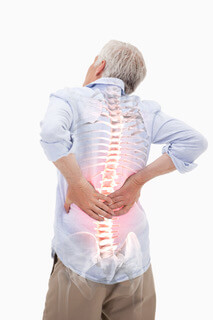Chronic Pain
What is chronic pain?
Chronic pain is typically defined as pain that persists past the normal time it takes for tissues to heal or pain that persists beyond 3-6
months.
To understand chronic pain, it is important to know how pain works.
With any injury, the tissues that are damaged send signals through our nerves to the brain to tell us that there is danger and that something is wrong. The brain then responds by sending back pain signals to the damaged tissues so we know to
take ourselves out of danger and to rest and recover. Tissues like muscles and ligaments can take 6-12 weeks to heal depending on the
severity of damage while bones can take a few months. As we heal, the tissues send fewer signals to the brain and in return, the sensation
of pain slowly goes away.
that there is danger and that something is wrong. The brain then responds by sending back pain signals to the damaged tissues so we know to
take ourselves out of danger and to rest and recover. Tissues like muscles and ligaments can take 6-12 weeks to heal depending on the
severity of damage while bones can take a few months. As we heal, the tissues send fewer signals to the brain and in return, the sensation
of pain slowly goes away.
In some cases like arthritis, chronic pain is often diagnosed due to the nature of the condition. Arthritis is a progressive, degenerative condition where the tissues will continue to send intermittent alarm signals to the brain when they are overloaded or put through too much strain.
Other times, the damaged tissues may be healing but the signals between the tissues and the brain continue on. The cause of this is not always clear but can be because the alarm or danger signal receptors in the healing tissues continue to be replaced instead of reducing their numbers or, the nerve fibres that send the signals become confused.
The brain can also affect the amount of pain as our emotions are closely linked to the part of the brain that processes these danger tissue
signals. If we are stressed, anxious, unwell or angry, our pain symptoms can feel worse as the brain fires more signals. If we are happy and
well, the part of our brain that processes pain will be less excitable, firing less signals and in return, we may feel less
pain.
So with all this information, how is chronic pain managed?
The main aim of chronic pain management should be to understand how chronic pain works and to improve quality of life by reducing the impact of pain in your day to day activities.
Treatment can include:
- Prescribed medication
- Chronic pain education
- Hands on treatment like massage and joint mobilisation
- Acupuncture or dry needling
- Improving your wellbeing through activities or hobbies that you enjoy
- Exercising to help strengthen and stabilise the affected area
How can physiotherapy help with chronic pain?
It is very common for someone with chronic pain to see a physiotherapist. Your physiotherapist can supply hands on treatment where needed but will also focus on providing a treatment plan that will help to make physical changes in an aim to minimise how pain may limit your daily activities.
Here at Revive, our physiotherapists have experience supplying postural advice, chronic pain education, hands on treatment and home exercise programs for individuals with chronic pain. Revive also offers exercise therapy sessions where you engage in a tailored exercise program integrating rehabilitation tools, therapeutic exercise and Pilates. This is an excellent way to help strengthen and stabilise the affected area, work towards your own exercise goals and improve your pain tolerance and fitness for daily activities in an aim to invoke long term changes.
.svg)